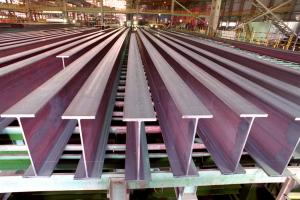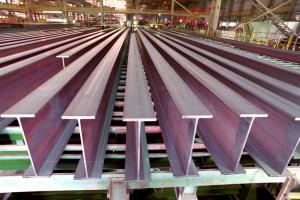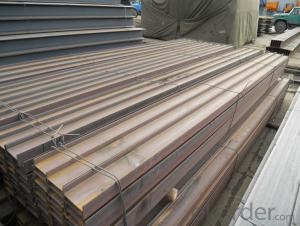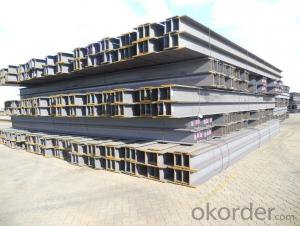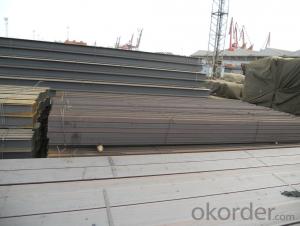JIS SS400 H Beam With High Quality
- Loading Port:
- China Main Port
- Payment Terms:
- TT or LC
- Min Order Qty:
- -
- Supply Capability:
- -
OKorder Service Pledge
OKorder Financial Service
You Might Also Like
Product Description:
OKorder is offering JIS SS400 H beam with high quality at great prices with worldwide shipping. Our supplier is a world-class manufacturer of steel, with our products utilized the world over. OKorder annually supplies products to European, North American and Asian markets. We provide quotations within 24 hours of receiving an inquiry and guarantee competitive prices.
Product Applications:
JIS SS400 H beam with high quality are ideal for structural applications and are widely used in the construction of buildings and bridges, and the manufacturing, petrochemical, and transportation industries.
Product Advantages:
OKorder's JIS SS400 H beam with high quality are durable, strong, and resist corrosion.
Main Product Features:
· Premium quality
· Prompt delivery & seaworthy packing (30 days after receiving deposit)
· Corrosion resistance
· Can be recycled and reused
· Mill test certification
· Professional Service
· Competitive pricing
Product Specifications:
1. Standard: JIS 3192
2. Grade: SS400 or Equivalent
3. Length: 10m, 12m as following table
4. Invoicing on theoretical weight or actual weight as customer request
5.Payment: TT or L/C
Size and Mass of H beam:
Size (mm) | Mass (Kg/m) | Size (mm) | Mass (Kg) |
100*100*6.0 | 16.9 | 148*100*6.0 | 20.7 |
125*125*6.5 | 23.6 | 150*150*7.0 | 31.1 |
150*75*5.0 | 14.0 |
1. Packing: it is nude packed in bundles by steel wire rod
2. Bundle weight: not more than 3.5MT for bulk vessel; less than 3 MT for container load
3. Marks:
Color marking: There will be color marking on both end of the bundle for the cargo delivered by bulk vessel. That makes it easily to distinguish at the destination port.
Tag mark: there will be tag mark tied up on the bundles. The information usually including supplier logo and name, product name, made in China, shipping marks and other information request by the customer.
If loading by container the marking is not needed, but we will prepare it as customer request.
4. Transportation: the goods are delivered by truck from mill to loading port, the maximum quantity can be loaded is around 40MTs by each truck. If the order quantity cannot reach the full truck loaded, the transportation cost per ton will be little higher than full load.
5. Delivered by container or bulk vessel
FAQ:
Q1: Why buy Materials & Equipment from OKorder.com?
A1: All products offered byOKorder.com are carefully selected from China's most reliable manufacturing enterprises. Through its ISO certifications, OKorder.com adheres to the highest standards and a commitment to supply chain safety and customer satisfaction.
Q2: Can fit in the containers of 20fts the steel beams of 6M?
A2: No proble, we can put them into the containers in the form sideling.
Q3: How soon can we receive the product after purchase?
A3: Within three days of placing an order, we will begin production. The specific shipping date is dependent upon international and government factors, but is typically 7 to 10 workdays.
Images:
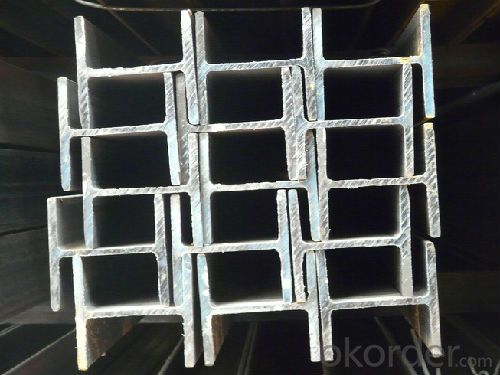
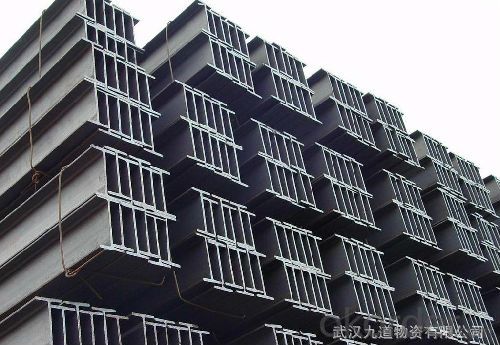
- Q:What are the factors that affect the cost of steel H-beams?
- There are several factors that can affect the cost of steel H-beams: 1. Raw material costs: The cost of the raw materials used to manufacture steel H-beams, such as iron ore and coal, can have a significant impact on the overall cost. Fluctuations in the prices of these materials, influenced by factors like supply and demand, can directly affect the cost of producing steel H-beams. 2. Manufacturing process: The method used to manufacture steel H-beams can also impact their cost. Different manufacturing processes, such as hot-rolling or cold-forming, require varying levels of energy, labor, and equipment, which can affect the overall cost. 3. Size and weight: The size and weight of the steel H-beams can impact the cost. Larger and heavier beams require more raw material and may require additional handling and transportation costs, which can increase the overall price. 4. Market demand: The demand for steel H-beams can also affect their cost. If there is a high demand for these beams, prices may increase due to limited supply. Conversely, if the demand is low, prices may be lower as manufacturers compete for customers. 5. Trade policies and international market conditions: Trade policies and international market conditions can also impact the cost of steel H-beams. Factors such as tariffs, import restrictions, and currency exchange rates can affect the cost of raw materials and the overall cost of production, which in turn can impact the final price of the beams. 6. Manufacturing location: The geographical location of the manufacturing facility can also play a role in the cost of steel H-beams. Different regions may have varying labor costs, energy costs, and transportation costs, all of which can affect the final price of the beams. 7. Quality and specifications: The quality and specifications of the steel H-beams can also influence their cost. Higher quality beams that meet stricter standards and specifications may command a higher price compared to lower quality beams. Overall, the cost of steel H-beams is influenced by various factors, including raw material costs, manufacturing process, size and weight, market demand, trade policies, manufacturing location, and quality and specifications. Understanding these factors can help buyers and sellers make informed decisions and negotiate prices effectively.
- Q:What are the different bracing methods for steel H-beams?
- Steel H-beams can be braced using various methods to enhance their support and stability, particularly when exposed to heavy loads or lateral forces. One effective bracing approach involves the utilization of diagonal members, which are connected to the H-beam's flanges at different points along its length. These diagonal members play a crucial role in distributing the load and transferring forces to the vertical supports. This, in turn, enhances the overall strength and stability of the H-beam. Another method entails the use of horizontal members, which are connected to the flanges of the H-beam at regular intervals. These horizontal members prevent the H-beam from buckling or twisting when subjected to heavy loads, ensuring its rigidity and stability. Aside from diagonal and lateral bracing, there are other techniques that can be employed based on the specific requirements of the structure. Moment connections, for instance, are utilized to resist rotational forces, while shear connections facilitate the transfer of shear forces between different members. Ultimately, the choice of bracing method for steel H-beams depends on factors such as load requirements, structural design, and project conditions. By meticulously considering these factors and selecting the appropriate bracing method, engineers can effectively support steel H-beams and ensure their ability to withstand the forces they will encounter.
- Q:Can steel H-beams be used for sports arenas?
- Yes, steel H-beams can be used for sports arenas. They are commonly used for structural support in large and complex building projects, including sports arenas, due to their strength, durability, and ability to withstand heavy loads. The use of steel H-beams provides a reliable and sturdy framework for the construction of sports arenas, ensuring the safety and stability of the structure.
- Q:How do steel H-beams perform in corrosive environments?
- Steel H-beams perform well in corrosive environments due to their high resistance to corrosion. The protective oxide layer that forms on the surface of steel helps prevent further corrosion, making them a reliable choice for such conditions.
- Q:Can steel H-beams be used for retail buildings?
- Yes, steel H-beams can be used for retail buildings. Steel H-beams are commonly used in construction due to their strength, durability, and versatility. Retail buildings often require large open spaces and flexible layouts, and steel H-beams provide the structural support needed to achieve these requirements. Additionally, steel is a sustainable and cost-effective building material, making it a popular choice for retail buildings. Whether it's for supporting the roof, creating mezzanine floors, or constructing the framework, steel H-beams can be effectively utilized in the construction of retail buildings.
- Q:What are the mechanical properties of steel H-beams?
- Steel H-beams possess a variety of mechanical characteristics that render them suitable for a broad range of uses. To commence, H-beams exhibit a remarkable degree of tensile strength, enabling them to endure substantial amounts of tension or pulling forces without fracturing or distorting. This attribute renders them ideal for implementation in structures that necessitate the support of hefty loads, such as bridges or high-rise buildings. Moreover, H-beams boast exceptional yield strength, denoting the extent of stress a material can endure prior to undergoing permanent deformation. This feature guarantees that H-beams can withstand bending or buckling under substantial loads, thereby ensuring structural stability and preventing collapse. An additional significant mechanical property of steel H-beams is their rigidity or modulus of elasticity. This attribute determines the extent to which a material will deform under a given amount of stress. H-beams possess a high modulus of elasticity, signifying that they are comparatively inflexible and can sustain their shape and structural integrity even when subjected to substantial loads. Furthermore, steel H-beams exhibit commendable resistance to fatigue, permitting them to endure repeated cycles of loading and unloading without failure. This characteristic is pivotal in structures subject to dynamic loads, such as bridges or cranes, where the material is incessantly exposed to varying forces. Lastly, H-beams possess exceptional weldability, facilitating their simple fusion to form larger structures or modify existing ones. This attribute is crucial for construction endeavors that demand flexibility and adaptability in design. In conclusion, the mechanical properties of steel H-beams, comprising high tensile strength, yield strength, rigidity, fatigue resistance, and weldability, render them a popular choice in the fields of structural engineering and construction.
- Q:Are steel H-beams suitable for use in high-rise buildings?
- Yes, steel H-beams are suitable for use in high-rise buildings. They provide excellent structural support, allowing for the construction of tall and sturdy buildings. The H-shape design of these beams offers superior strength and load-bearing capacity, making them an ideal choice for handling the vertical and horizontal forces experienced in high-rise structures.
- Q:Are steel H-beams resistant to seismic activity?
- Yes, steel H-beams are generally considered to be resistant to seismic activity. Steel is a highly durable and strong material, which makes it well-suited for withstanding the forces generated during seismic events. H-beams, specifically, are designed to distribute the load evenly across their length, providing excellent structural support against both vertical and lateral movements. Moreover, steel H-beams are commonly used in earthquake-prone regions due to their superior seismic resistance. The inherent flexibility and elasticity of steel allow it to absorb and dissipate seismic energy, minimizing the damage caused by ground shaking. Additionally, steel H-beams are often interconnected with other structural elements, such as columns and braces, to form a seismic-resistant system that can effectively absorb and redirect seismic forces. However, it is important to note that the seismic resistance of steel H-beams can vary depending on various factors, such as the design, quality of construction, and adherence to building codes and regulations. Proper engineering and construction practices must be followed to ensure that steel H-beams are appropriately designed and installed to withstand the specific seismic conditions of a given area. Overall, when properly designed and constructed, steel H-beams offer excellent resistance to seismic activity and are widely used in earthquake-resistant building structures.
- Q:What are the acoustic properties of steel H-beams?
- Steel H-beams, also known as I-beams, possess several distinct acoustic properties due to their composition and shape. Firstly, steel is a dense and rigid material, which contributes to its excellent sound transmission properties. H-beams made of steel can effectively transfer sound energy, allowing them to efficiently conduct sound waves. This characteristic makes steel H-beams an ideal choice in construction applications where soundproofing or acoustic isolation is desired. Moreover, the shape of H-beams plays a significant role in their acoustic properties. The I-shaped design of H-beams helps to distribute sound waves evenly across the cross-sectional area, minimizing the concentration of energy at specific points. This dispersion of sound energy can prevent the occurrence of resonances or standing waves, which can cause unwanted vibrations and noise. Furthermore, steel H-beams have a high natural frequency, which refers to the rate at which an object naturally vibrates. The high natural frequency of steel H-beams helps to attenuate low-frequency sounds. Low-frequency noise, such as heavy machinery or traffic rumble, is effectively absorbed and dampened by the steel H-beams, resulting in a quieter environment. Lastly, steel H-beams have good structural stability and can effectively resist vibrations caused by external forces or impacts. This stability reduces the likelihood of sound distortion or reverberation within the beam itself, ensuring that sound waves pass through without significant alterations. In summary, the acoustic properties of steel H-beams are characterized by their efficient sound transmission, dispersion of sound energy, attenuation of low-frequency noise, and structural stability. These properties make steel H-beams a desirable choice for applications that require effective soundproofing, acoustic isolation, and vibration resistance.
- Q:What are steel H-beams?
- Steel H-beams are structural beams that are made of steel and have an H-shaped cross-section. They are commonly used in construction projects, particularly in the building of bridges, buildings, and other structures that require strong support. H-beams are designed to distribute weight evenly along their length and provide high strength and stability. The H shape allows the beam to withstand heavy loads and resist bending or twisting. These beams are typically made from rolled steel and can vary in size and weight depending on the specific application. Steel H-beams are preferred over other types of beams due to their durability, versatility, and cost-effectiveness.
1. Manufacturer Overview |
|
|---|---|
| Location | |
| Year Established | |
| Annual Output Value | |
| Main Markets | |
| Company Certifications | |
2. Manufacturer Certificates |
|
|---|---|
| a) Certification Name | |
| Range | |
| Reference | |
| Validity Period | |
3. Manufacturer Capability |
|
|---|---|
| a)Trade Capacity | |
| Nearest Port | |
| Export Percentage | |
| No.of Employees in Trade Department | |
| Language Spoken: | |
| b)Factory Information | |
| Factory Size: | |
| No. of Production Lines | |
| Contract Manufacturing | |
| Product Price Range | |
Send your message to us
JIS SS400 H Beam With High Quality
- Loading Port:
- China Main Port
- Payment Terms:
- TT or LC
- Min Order Qty:
- -
- Supply Capability:
- -
OKorder Service Pledge
OKorder Financial Service
Similar products
New products
Hot products
Related keywords
